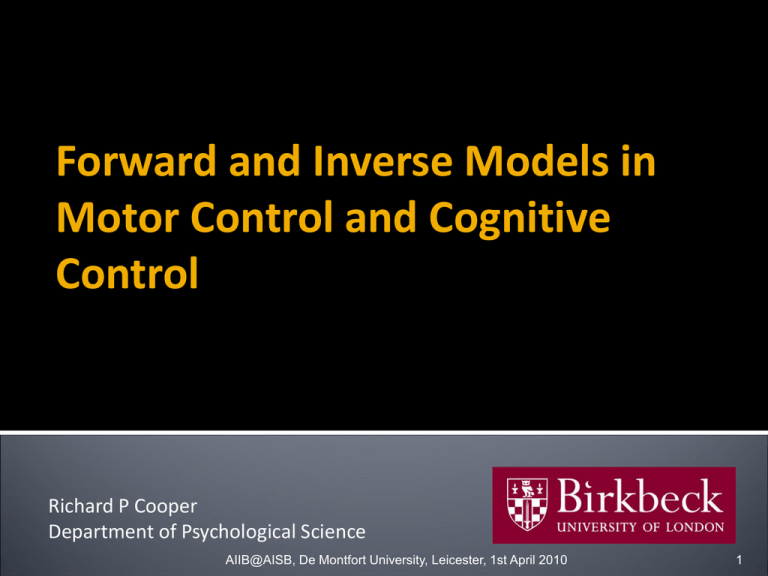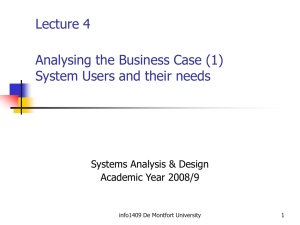PPT version
advertisement

Forward and Inverse Models in Motor Control and Cognitive Control Richard P Cooper Department of Psychological Science AIIB@AISB, De Montfort University, Leicester, 1st April 2010 1 Overview The problem of Motor Control Inverse and forward models The problem of Cognitive Control Two accounts of Cognitive Control Botvinick et al (2001) Alexander & Brown (2010) …and some limitations of those accounts Inverse models in cognitive control? AIIB@AISB, De Montfort University, Leicester, 1st April 2010 2 The Problem of Motor Control Many simple acts require us to bring together simultaneously multiple objects/limbs: Consider serving a tennis ball Many sequential tasks require fast motor movements that, due to neural timing constraints, must be programmed in advance: Consider a musician sight reading What properties are required of a (motor) control system with these capabilities? AIIB@AISB, De Montfort University, Leicester, 1st April 2010 3 Inverse and Forward Models in Motor Control (Wolpert & Ghahramani, 2000) AIIB@AISB, De Montfort University, Leicester, 1st April 2010 4 Inverse and Forward Models in Motor Control Inverse model (motor planning): Allows us to derive the motor command required to bring about a desired state Forward dynamic model (state prediction): Allows us to derive the anticipated state of the motor system when we perform a motor act Forward sensory model (sensory prediction): Allows us to predict the anticipated sensory feedback from a motor act, as required by error correction AIIB@AISB, De Montfort University, Leicester, 1st April 2010 5 An Aside: Models and mental simulation The use of forward/inverse models does not necessarily imply mental simulation Models may be impoverished Simple learnt associations: [current state x desired outcome] required action AIIB@AISB, De Montfort University, Leicester, 1st April 2010 6 Biological Evidence for Inverse and Forward Motor Models Kawato (1999): The cerebellum contains multiple forward and inverse models that compete when learning new motor skills Ideomotor apraxia may be understood in terms of deficient internal models: Sirigu et al (1996): Parietal apraxic patients show motor imagery deficits Buxbaum et al (2005): Motor imagery and performance on an imitation task correlate (r > 0.75) AIIB@AISB, De Montfort University, Leicester, 1st April 2010 7 The AIIB Question Control theory has helped understand the biological basis of motor control Do similar problems arise in cognitive control? Can control theory inform cognitive theories of control? AIIB@AISB, De Montfort University, Leicester, 1st April 2010 8 The Problem of Cognitive Control: Online performance adjustments in CRT Lamming (1968): AIIB@AISB, De Montfort University, Leicester, 1st April 2010 9 The Problem of Cognitive Control: Online performance adjustments in Stroop Tzelgov et al (1992) on Stroop interference: RED XXX RED Stroop interference is: Low, when incongruent Stroop trials are frequent High, when incongruent Stroop trials are rare AIIB@AISB, De Montfort University, Leicester, 1st April 2010 10 The Botvinick et al (2001) Solution: Conflict Monitoring Claim: ACC monitors “information processing” conflict High conflict causes an adjustment in online control But what is “information processing conflict”, and how is control adjusted? AIIB@AISB, De Montfort University, Leicester, 1st April 2010 11 The Alexander & Brown Solution: Performance Monitoring and the PRO model Given a planned response, the model makes an outcome prediction (i.e. a forward model) Pro-active control may then: Veto the plan (and presumably adjust control parameters) Discrepancies are used to learn R-O mapping AIIB@AISB, De Montfort University, Leicester, 1st April 2010 12 Issues Arising from Models of Control So the concept of (forward) model has some currency in the cognitive control literature But … Alexander & Brown (2010): The rationale for forward models is limited (basically so we can veto erroneous responses) And … a problem for both Botvinick et al (2001) and Alexander & Brown (2010): In both cases the control signal is a scalar, yet current theories of control suggest multiple control functions AIIB@AISB, De Montfort University, Leicester, 1st April 2010 13 Multiple Control Functions: Miyake et al (2000) AIIB@AISB, De Montfort University, Leicester, 1st April 2010 14 Multiple Control Functions: Shallice et al (2008) AIIB@AISB, De Montfort University, Leicester, 1st April 2010 15 Putative Control Parameters Attentional bias Response inhibition Response threshold Memory maintenance Task switch strength Energisation Attentiveness AIIB@AISB, De Montfort University, Leicester, 1st April 2010 16 Can the Models be Extended to Multiple Control Functions? Not easily: There is a problem of credit assignment Typically the feedback is a scalar value How can the system know which of several control parameters to adjust to improve performance? One possibility: one scalar for each parameter (e.g., response conflict attentional bias) AIIB@AISB, De Montfort University, Leicester, 1st April 2010 17 And Another Thing … A second problem for both models: How does the system know/set sensible control parameters (e.g. on the first trial of a task)? If I explain to you the rules of CRT (or the Flanker Task or Stroop), then it is possible to answer correctly on the first trial And even more so if you have done the task before AIIB@AISB, De Montfort University, Leicester, 1st April 2010 18 A Speculative Solution Both problems can be answered if the cognitive control system makes use of inverse models: What control parameter settings are required to generate the desired response? Moreover, an inverse model can associate a set of control parameters with a task So it avoids the problem of being limited to a single scalar control parameter AIIB@AISB, De Montfort University, Leicester, 1st April 2010 19 Extended PRO Model AIIB@AISB, De Montfort University, Leicester, 1st April 2010 20 Further Speculations (Learning) Inverse models of control may be learnt through reinforcement learning much as in Alexander & Brown’s PRO model But there is no credit assignment problem at this stage: We are just associating a task with a set of control parameters AIIB@AISB, De Montfort University, Leicester, 1st April 2010 21 Further Speculations (Novel Tasks) How do we construct an inverse model for a novel tasks: Very speculatively (and extrapolating again from the motor control literature), they may be based on a mixture of experts idea An initial inverse model for a novel task will require online adjustment: The problem of credit assignment is pushed onto learning appropriate online control parameter adjustments AIIB@AISB, De Montfort University, Leicester, 1st April 2010 22 Tentative Answer to the AIIB Question(s) Do similar problems arise in cognitive control? Yes - similar problems do arise in cognitive control Can control theory inform cognitive theories of control? Yes - Control theory quite possibly can inform cognitive theories of control AIIB@AISB, De Montfort University, Leicester, 1st April 2010 23






